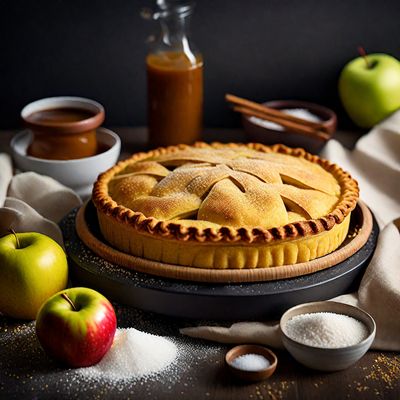
Ingredient
Short sweet pastry dough (pate sucree)
The Art of Delicate Crusts: Mastering Short Sweet Pastry Dough
Short sweet pastry dough, or pate sucree, is a delicate and crumbly dough made from a combination of flour, butter, sugar, and sometimes eggs. It has a higher ratio of fat to flour compared to other pastry doughs, resulting in a tender and melt-in-your-mouth texture. The dough is typically sweetened with sugar, which adds a subtle sweetness to complement the fillings or toppings used in pastries.
Origins and history
The origins of short sweet pastry dough can be traced back to French pastry traditions, where it is known as pate sucree. This dough has been used for centuries in classic French pastries such as tarts, quiches, and fruit pies. Over time, it has become a staple in pastry kitchens around the world, with variations and adaptations to suit different culinary traditions and preferences.
Nutritional information
Short sweet pastry dough is not a significant source of essential nutrients, but it contributes calories, carbohydrates, and fats to pastries. The exact nutritional content may vary depending on the specific recipe and ingredients used. It is best enjoyed in moderation as part of a balanced diet that includes a variety of nutrient-dense foods.
Allergens
Short sweet pastry dough may contain allergens such as wheat, dairy (butter), and eggs, depending on the specific recipe. Individuals with allergies or intolerances to these ingredients should exercise caution and check the ingredient list or consult with the baker before consuming pastries made with this dough.
How to select
When selecting short sweet pastry dough, look for pre-made dough in the refrigerated section of grocery stores or specialty baking shops. Alternatively, you can make your own dough using a trusted recipe and high-quality ingredients. The dough should be firm and not overly sticky. Avoid dough that appears dry or crumbly, as it may result in a less desirable texture in the finished pastries.
Storage recommendations
To maintain the freshness and quality of short sweet pastry dough, store it in the refrigerator in an airtight container or wrapped tightly in plastic wrap. This will help prevent the dough from drying out and absorbing odors from other foods. It is best used within a few days of preparation for optimal results. If storing for longer periods, the dough can be frozen and thawed before use.
How to produce
Short sweet pastry dough can be made at home using a few simple ingredients and techniques. It involves combining flour, butter, sugar, and sometimes eggs in a food processor or by hand until the mixture resembles coarse crumbs. The dough is then chilled, rolled out, and used to line tart pans or form the base for other pastries. It is important to handle the dough gently and avoid overworking it to maintain its delicate texture.
Preparation tips
When working with short sweet pastry dough, it is important to keep the dough and ingredients cold to prevent the butter from melting and compromising the texture. Use a light touch when rolling out the dough to avoid overworking it, which can result in a tough crust. Blind baking the dough before adding fillings can help ensure a crisp and fully cooked crust. Experiment with different fillings, such as fruit, custard, or chocolate, to create a variety of sweet pastries.
Culinary uses
Short sweet pastry dough is a versatile base for a wide range of sweet pastries. It is commonly used to make fruit tarts, custard tarts, quiches, and pies. The crumbly texture and buttery flavor of the dough provide a perfect contrast to the creamy or fruity fillings. It can also be used to make tart shells or crusts for desserts such as cheesecake or lemon bars. The possibilities are endless, limited only by one's imagination and creativity in the kitchen.
Availability
Short sweet pastry dough, or pate sucree, is commonly used in French and European pastry traditions. It can be found in bakeries, patisseries, and specialty dessert shops in countries such as France, Italy, and Switzerland. It is also used in various culinary traditions around the world, with adaptations and variations to suit local tastes and preferences.
More ingredients from this category
Recipes using Short sweet pastry dough (pate sucree)

Chinese-style Apple Pie
Golden Apple Delight: A Fusion of American and Chinese Flavors

Mauritian Clanger
Savory Delight: Mauritian Clanger - A Fusion of Flavors

Hyderabadi-style Cinnamon Rolls
Nawabi Cinnamon Delights: Hyderabadi-style Franzbrötchen

Norwegian Cinnamon Buns
Scrumptious Cinnamon Delights: Norwegian Skillingsboller

Sonhos de Banana (Banana Dreams)
Golden Banana Pillows: A Sweet Delight from Brazil

Mirabelle Plum Tart
Golden Delight: Mirabelle Plum Tart

Curaçao-style Steamed Custard Buns
Tropical Delight: Curaçao-inspired Steamed Custard Buns


